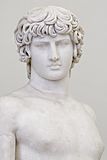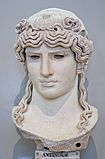Antinous Mondragone facts for kids
Quick facts for kids Antinous Mondragone |
|
|---|---|
 |
|
| Year | c. 130-138 AD. |
| Type | White marble |
| Dimensions | 95 cm (37 in) |
| Location | Louvre, Paris |
The Antinous Mondragone is a large marble head, about 95 centimeters (37 inches) tall. It shows Antinous, a young man who was honored like a god after his death. This huge head was made between 130 AD and 138 AD.
People believe it was found in the early 1700s near the old Roman city of Tusculum. After it was found, it became part of the Borghese Collection at the Villa Mondragone. In 1807, it was sold to Napoleon Bonaparte. Today, you can see it at the Louvre museum in Paris, France.
This sculpture was made during the time of Emperor Hadrian, who ruled from 117 AD to 138 AD. Antinous was very important to Hadrian. Not much is known about their friendship, so many theories exist about it. There are also many ideas about Antinous's sudden death in 130 AD.
This sculpture is one of many artworks made for the "cult of Antinous." A cult, in this case, means a group of people who honored Antinous after he died. This group formed because Emperor Hadrian was very sad about Antinous's death. There are three main types of statues made for Antinous. This one is called the Mondragone type. You can tell it apart by its special hairstyle, which looks like the Greek god Dionysus.
Contents
Who Was Antinous?
Antinous and Emperor Hadrian

Antinous was a young boy from a place called Bithynium, in Bithynia. He was brought to Imperial Rome when he was young. Because of this, we don't know much about his early life or family.
Historians believe Hadrian's friendship with Antinous began when Antinous was a teenager. Based on his many statues, historians think Antinous was about 18 to 20 years old when he died. This means he was likely born around 110 to 112 AD.
The exact cause of Antinous's death in 130 AD is not fully known. There are many different ideas and guesses about how he died.
The Cult of Antinous
The cult of Antinous was very active and lasted a long time. It was even more widespread than the groups that honored Emperor Hadrian himself. Antinous's image is one of the most famous from ancient times. It is also one of the most easily recognized, along with images of emperors Hadrian and Augustus.
The main centers for honoring Antinous were in Alexandria and Asia Minor. But people honored him or were influenced by him in many other places, even in North Africa. A city in Egypt called Antinoöpolis was a major center for his cult. Two temples were built there to honor him.
Many other cities also had important cults with temples and priests for Antinous. These included Hermopolis, Oxyrhynchus, and Tebtynis. At least thirteen cities in mainland Greece honored Antinous. Groups of worshipers were also found throughout the Peloponnese region.
In Mantineia, Antinous was seen as a local god, and they had two temples for him. Athens had at least four sculptures of Antinous, plus other ways people showed their devotion. Antinous's birthplace, Bithynia, in Asia Minor, had one of the largest and strongest cults. In Asia Minor, about 27 cities are known to have honored Antinous, such as Smyrna, Nikomedia, and Taros.
In what is now modern Italy, at least ten areas showed some form of worship for Antinous. There is evidence of seven temples built in his honor. The Mondragone head was found near the Roman city of Tusculum. The widespread honoring of Antinous as a god, and the many images of him, helped connect the Greek, Roman, and Egyptian Empires.
What the Sculpture Looks Like
You can tell this sculpture is Antinous by his eyebrows, full lips, and serious expression. His head is also tilted down and to the right. His smooth skin and detailed hair, parted in the middle, look like statues of Dionysus (also known as Bacchus) and Apollo from the Hellenistic period.
The hair on the sides of this Antinous head is similar to how Dionysus is shown. This suggests a connection between the two through their hairstyles. An ancient writer named Pausanias noted that some statues of Antinous, like the one in Mantineia, looked similar to Dionysus.
The Mondragone head was part of a huge statue used to worship Antinous as a god. These types of statues are called "acrolithic." This means artists used a mix of wood and stone to build them. For the Antinous Mondragone, marble was used for parts like the head, where skin would be visible. Wood was used for the parts of the statue that would be covered by clothing. This method was often used in places where expensive materials like marble were hard to get or too costly.
There are 31 holes of different sizes drilled into the head. These holes were for attaching a metal garland, possibly made of ivy or vine leaves. This head decoration might have been a tainia, which was a type of headband worn by Greeks during festivals. It was also shown on statues of gods. The sculpture's eyes are missing now. They were likely made of bronze, ivory, or colored stone.
Different Styles
Most art of Antinous fits into one of three main styles: the Main type, the Egyptianizing type, or the Mondragone type. The Main type has two versions, A and B, which are different based on how the hair is arranged on the forehead.
The Egyptianizing type shows influences from Egypt. An example of this style is the Antinous statue at Hadrian's Villa in Tivoli. The Mondragone type, like the Egyptianizing type, shows that there wasn't just one way to make a statue of Antinous.
Even though the three types look different, many statues of Antinous are influenced by or use features from young gods like Dionysus. Some art historians believe that without these borrowed features, the statues of Antinous would just look like another handsome young man from Imperial Rome.
Where It Came From
In the early 1600s, the gallery at Palazzo Mondragone started putting pedestals under their ancient statues, including large busts. These busts were often displayed in pairs of male and female figures. The male figure, which people thought was Julius Caesar, was replaced by the Mondragone head after it was found.
It is believed to have been found near Tusculum, specifically at Frascati, between 1713 and 1729. It was definitely displayed as part of the Borghese collection at their Villa Mondragone. However, some people argue against these dates. They say that the Antinous head was seen in the gallery much earlier, in 1687, by a Swedish architect named Nicodemus Tessin the Younger.
In 1807, Napoleon bought the Antinous head as part of a large purchase of Borghese collections. The Antinous head was sold for one of the highest prices in the whole collection. Later, a brown layer of wax was added to the head to make it look less shiny. Plaster was also added around the neck to make the statue seem more complete. Both of these additions have since been removed during recent cleaning.
Today, the Antinous Mondragone is kept at the Louvre Museum in Paris. It has also traveled for exhibitions. In 2006, it went to the Henry Moore Institute in Leeds, UK, for an exhibition called "Antinous: The Face of the Antique." It returned to the United Kingdom in 2008 for the British Museum's exhibition "Hadrian: Empire and Conflict."
Gallery
See also
- Antinous Farnese
- Capitoline Antinous
- Statue of Antinous (Delphi)
- Townley Antinous






